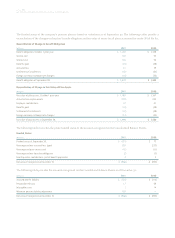American Express 2001 Annual Report Download - page 66
Download and view the complete annual report
Please find page 66 of the 2001 American Express annual report below. You can navigate through the pages in the report by either clicking on the pages listed below, or by using the keyword search tool below to find specific information within the annual report.
axp_64
NOTES TO CONSOLIDATED FINANCIAL STATEMENTS
The company is committed to extend credit to certain Cardmembers as part of established lending product agreements. Many
of these are not expected to be drawn; therefore, total unused credit available to Cardmembers does not represent future cash
requirements. The company’s Charge Card products have no preset spending limit and are not reflected in unused credit available
to Cardmembers.
The company issues commercial and other letters of credit to facilitate the short-term trade-related needs of its banking clients,
which typically mature within six months. At December 31, 2001 and 2000, the company held $583 million and $687 million,
respectively, of collateral supporting standby letters of credit and guarantees and $159 million and $242 million, respectively, of
collateral supporting commercial and other letters of credit. In addition to the contingencies and commitments listed above, the
company has entered into many other contracts in the normal course of business that involve future cash payments that are either
required or contingent upon the occurrence of certain events.
Other financial institutions have committed to extend lines of credit to the company of $13.8 billion and $12.4 billion at December
31, 2001 and 2000, respectively.
The company leases certain office facilities and operating equipment under noncancellable and cancellable agreements. Total rental
expense amounted to $491 million, $477 million and $452 million in 2001, 2000 and 1999, respectively. At December 31, 2001, the
minimum aggregate rental commitment under all noncancellable leases (net of subleases) was (millions): 2002, $354; 2003, $284;
2004, $210; 2005, $175; 2006, $146; and thereafter, $1,568.
The company is not a party to any pending legal proceedings that, in the opinion of management, would have a material adverse
effect on the company’s financial position.
Note 12 ❚FAIR VALUES OF FINANCIAL INSTRUMENTS
The following table discloses fair value information for financial instruments. Certain items, such as life insurance obligations,
employee benefit obligations and investments accounted for under the equity method are excluded. The fair values of financial
instruments are estimates based upon market conditions and perceived risks at December 31, 2001 and 2000 and require man-
agement judgment. These figures may not be indicative of their future fair values.
December 31, (Millions) 2001 2000
Carrying Fair Carrying Fair
Value Value Value Value
Financial Assets
Assets for which carrying values
approximate fair values $ 67,404 $ 67,404 $ 73,940 $ 73,940
Investments $ 46,488 $ 46,659 $ 43,747 $ 43,910
Loans $ 26,789 $ 25,441 $ 26,213 $ 26,118
Derivative financial instruments, net(a) $— $— $ 105 $ (93)
Financial Liabilities
Liabilities for which carrying values
approximate fair values $ 65,190 $ 65,190 $ 68,975 $ 68,975
Fixed annuity reserves $ 18,139 $ 17,672 $ 18,021 $ 17,479
Investment certificate reserves $ 8,205 $ 8,223 $ 7,322 $ 7,289
Long-term debt $ 7,788 $ 7,851 $ 4,711 $ 4,743
Separate account liabilities $ 24,280 $ 23,717 $ 28,792 $ 27,823
(a)Effective January 1, 2001, the company adopted SFAS No. 133, which requires all derivatives to be recognized as either assets or liabilities on the balance sheet and be measured at
fair value. Consequently, derivative financial instruments are included in assets and liabilities for which carrying values approximate fair values for 2001.
























